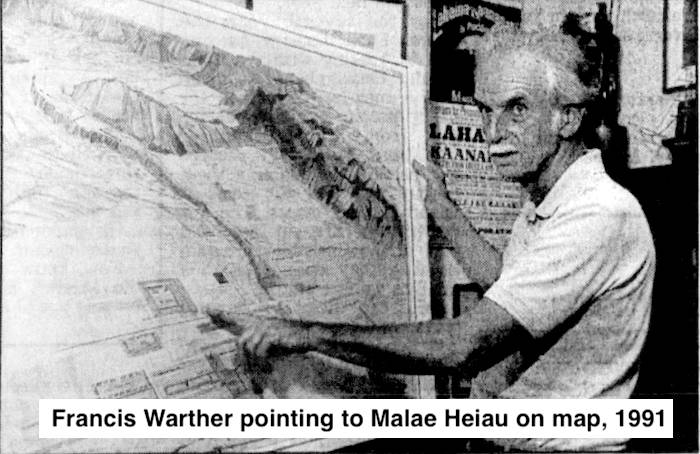Hawaiian hula, mythology and chants contain numerous references to relationships between heavenly bodies and heiau.
But, when retired architect and Kauai resident Francis X. Warther (1920-2013) first came to Kauai from the Mainland in 1980, only one person, Rubelitte Kawena Johnson at the University of Hawaii, had published material in which ancient Hawaiian architecture was also shown to be related to the heavens – a subject Warther was most interested in.
Warther’s fascination with “architectural astronomy,” went beyond what Johnson had written and led him to provided evidence in 1991 that the Hawaiian kahuna of old charged with building heiau actually positioned them in relation to the heavens.
One example Warther cited was the Malae Heiau, located above the mouth of the Wailua River on Kauai and built prior to 1200 AD roughly in the shape of the constellation Pegasus, named after the winged horse Pegasus in Greek mythology.
Since Hawaiian kahuna wanted heiau to be placed so as to align with planets and stars and thus provide a sense of unity linking the earth with the heavens, a kahuna centuries ago located the site where he could observe Pegasus at highest point, its zenith, in the heavens, and directed Malae Heiau to be built there.
What is more, the diagonals of Malae Heiau line up with the summer solstice (the day when the sun reaches its highest point in the sky).
Warther further stated that all heiau in Wailua Valley are not only aligned with the summit of Mount Waialeale – they also line up with the Belt of Orion, comprised of the stars Alnitak, Alnilam and Mintaka.
In fact, he said, if you orient the western wall of any heiau to 15 degrees east of north, the diagonal will automatically point to the summer solstice.
Warther even located a couple of heiau simply by determining where they should be situated according to the path of the sun and the stars.
“It’s not the heiau that is sacred; they were put on sacred places,” he said.
•••
Hank Soboleski has been a resident of Kauai since the 1960s. Hank’s love of the island and its history has inspired him, in conjunction with The Garden Island Newspaper, to share the island’s history weekly. The collection of these articles can be found here: https://bit.ly/2IfbxL9 and here https://bit.ly/2STw9gi Hank can be reached at hssgms@gmail.com



Retired UH Professor Rubellite Kawena Kinney Johnson invented the field of archeoastronomy in Hawaii. She translated Kumulipo into English. She wrote the chapter on Hawaiian religion in the report of the Native Hawaiians Study Commission about 35 years ago. She studied the alignment of the “birthing stones” at Kukaniloko, near Whitmore Village. Honpa Hongwanji recognized her years ago as a “Living Treasure” of Hawaii. She is a descendant of Kamehameha The Great, and also a descendant of 2 of the Mayflower pilgrims. I am sure she would support the telescopes being on the sacred place of Mauna Kea.
Ken, Francis X Warther was a colleague on Rubellite Johnson’s and I took the phone call she made to call him at his elderly living home to say goodbye to him before he died and to thank him for his work. If you think she would support the telescopes being placed on sacred Hawaiian land when all she has done for her entire life was to protect the aina from further desecration, you are not only delusional but you now have publicly insulted her. I am working on a book of his entire work that was passed along to me in order to preserve it and make it available for the next generation. I am not getting paid and I am not even Hawaiian, so if you want to insult a living legend like Rubellite and my mentor Francis Warther, please keep your mouth shut and go complain on another page.
Francis X. Warther, was also a proponent of preserving the heiau on the hill overlooking Hanalei Valley, on Kapaka Street (Pooku Stables), across from Church of the Pacific, Princeville where he said that on the Summer Solstice, both the sunrise and the sunset could be seen rising and setting on the horizon.
Dear C Martin – thank you for pointing this out and you are absolutely correct. I will be publishing this information this year about that site and many more so it can finally be available to the Kanaka Maoli to whom this knowledge belongs. Thank you for your comment and have a wonderful day.